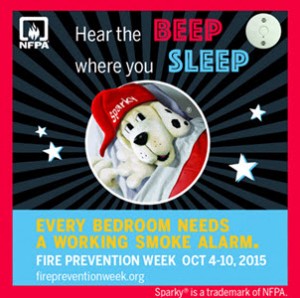[vc_row][vc_column][vc_column_text]At PuroClean Emergency Recovery Services because fire and smoke damage cleanup are part of the work we do every day, we’ve seen first hand the damage and devastation fires cause to homes and families. And, because of our experience helping people throughout the Greater Philadelphia and Southern New Jersey region recover from the devastating loss of home fires, each year we participate in National Fire Prevention Week.
And this year’s theme is “Hear the beep where you sleep”
[/vc_column_text][/vc_column][/vc_row][vc_row][vc_column width=”1/3″][vc_column_text]

[/vc_column_text][/vc_column][vc_column width=”2/3″][vc_column_text]Why?
Because most home fire deaths occur between the hours of 11 pm and 7 am – when most of us are tucked all warm and snuggly in our beds, blissfully unaware that there could be danger.
Of course being able to “hear the beep where you sleep” means you’ve got enough smoke alarms in your home. Fire research has demonstrated that with today’s modern furnishings, fires can spread more rapidly than in the past when more natural materials were used.
So having enough properly located smoke alarms is essential to maximize the amount of available escape time.
At a bare minimum: install smoke alarms inside and outside every sleep room and on every level of the home.
But remember: Older homes were built to earlier standards and building codes. They don’t usually meet the current standards. So if you live in an older home, take a walk around inside.
[/vc_column_text][/vc_column][/vc_row][vc_row][vc_column][vc_column_text]
Here are 8 Tips for Installing Smoke Alarms
Remember: there are two types of smoke alarms – ionization and photoelectric.
An ionization smoke alarm is generally more responsive to flaming fires
A photoelectric smoke alarm is generally more responsive to smoldering fires.
The best protection for your home and family is to install both types of alarms or combination ionization-photoelectric alarms.
What to do:
1. Choose smoke alarms that have the label of a recognized testing laboratory.
2. Install smoke alarms inside each bedroom, outside each sleeping area and on every level of the home, including the basement.
3. On levels without bedrooms, install alarms in the living room (or den or family room) or near the stairway to the upper level, or in both locations.
4. Smoke alarms installed in the basement should be installed on the ceiling at the bottom of the stairs leading to the next level.
5. Smoke alarms should be installed at least 10 feet (3 meters) from a cooking appliance to minimize false alarms when cooking.
6. Mount smoke alarms high on walls or ceilings (remember, smoke rises). Wall-mounted alarms should be installed not more than 12 inches away from the ceiling (to the top of the alarm).
7. If you have ceilings that are pitched, install the alarm within 3 feet of the peak but not within the apex of the peak (four inches down from the peak).
8. Keep manufacturer’s instructions for reference.
What not to do:
1. Don’t install smoke alarms near windows, doors, or ducts where drafts might interfere with their operation.
2. Never paint smoke alarms. Paint, stickers, or other decorations could keep the alarms from working.
3. For the best protection, interconnect all smoke alarms. When one smoke alarm sounds they all sound. Interconnection can be done using hard-wiring or wireless technology.
4. When interconnected smoke alarms are installed, don’t use alarms from different manufacturers. If the alarms aren’t compatible, they may not sound.[/vc_column_text][/vc_column][/vc_row][vc_row][vc_column][vc_column_text]
Please pin, tweet and post this infographic to help us get this Fire Prevention Week word out:
[caption id="attachment_8368" align="alignleft" width="822"] PuroClean Emergency Recovery Services is proud to participate in Fire Prevention Week
PuroClean Emergency Recovery Services is proud to participate in Fire Prevention Week
[/vc_column_text][/vc_column][/vc_row][vc_row][vc_column width=”1/4″][vc_facebook][/vc_column][vc_column width=”1/4″][vc_tweetmeme][/vc_column][vc_column width=”1/4″][vc_googleplus][/vc_column][vc_column width=”1/4″][vc_pinterest][/vc_column][/vc_row]
